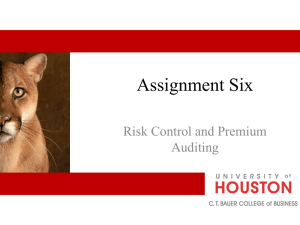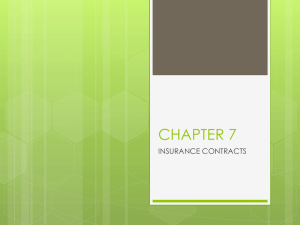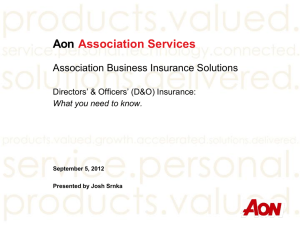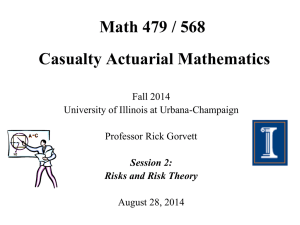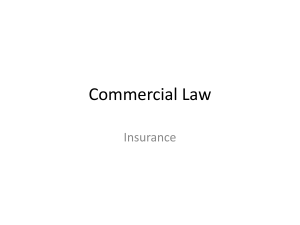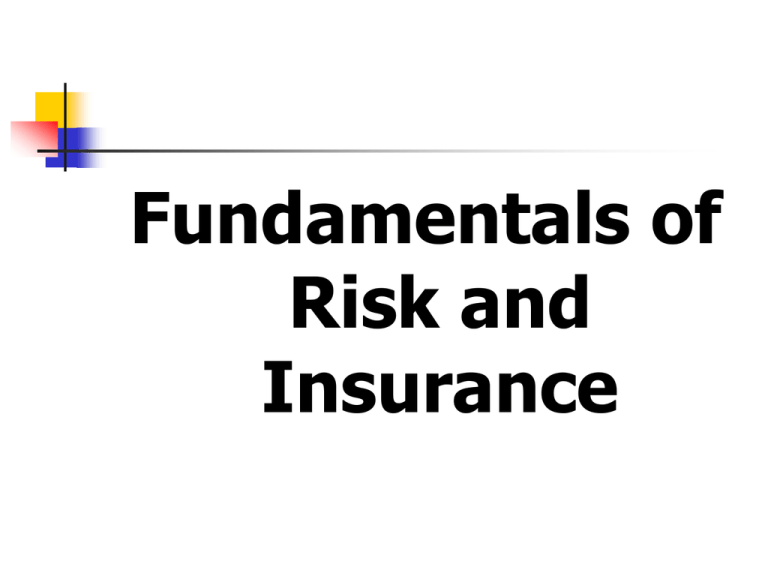
Fundamentals of
Risk and
Insurance
Chapter 1
The Problem of Risk
1. The concept of risk
Risk: a condition in which there is a
possibility of an adverse deviation
from a desired outcome that is
expected or hoped for
Peril: a cause of a loss
Hazard: a condition that may create or increase
the chance of a loss arising from a given peril
Three categories of hazards:
Physical hazards
Moral hazard
Morale hazard
2. Classifications of risk
Pure risk and speculative risk
Pure risk: the situations that involve
only the chance of loss or no loss
Speculative risk: a situation in which
there is a possibility of loss, but
also a possibility of gain
Chapter 2
Introduction to risk management
1. Risk management
Risk management is a scientific approach
to dealing with pure risks by
anticipating possible accidental losses
and designing and implementing
procedures that minimize the
occurrence of loss or the financial
impact of the losses that do occur
2. Risk management tools
Include two broad approaches:
(1) Risk control focuses on
minimizing the risk of loss
A. Risk avoidance
B. Risk reduction: loss prevention & loss
control
(2) Risk financing focuses on finding
funds to meet losses
(2) Risk financing focuses on finding
funds to meet losses
A. Risk retention (assumption)
Intentional and unintentional
B. Risk transfer
Insurance, hedging
Assume all risks that are not significant in
relation to the company’s financial
strength
Insure all risks not assumed
3. Risk management process
(1) Determination of objectives
(2) Identification of risks
(3) Evaluation of risks
(4) Considering alternatives and selecting
the risk treatment device
(5) Implementing the decision
(6) Evaluation and review
Determination of objectives
Post-loss objectives Pre-loss objectives
Survival
Economy
Continuity of operations
Reduction in anxiety
Earning stability
Meeting externally imposed
obligations
Continued growth
Social responsibility
Social responsibility
Chapter 3
The insurance device
1. The nature and functions of
insurance
(1) Risk sharing and risk transfer
A. Transferring or shifting risk from one
individual to a group
B. Sharing losses, on some equitable basis,
by all members of the group
(2) Insurance defined from the viewpoint
of the individual
Insurance is an economic device whereby
the individual substitutes a small
certain cost (the premium) for a large
uncertain financial loss (the
contingency insured against) that would
exist if it were not for the insurance
(3) Risk reduction through pooling
The law of large numbers
The larger the sample, the more accurate
will be the estimate of the probability
Once the estimate has been made, it must
be applied to a sufficient large number
of exposure units to permit the
underlying probability to work itself out
To make the estimate more accurate, we
use variance and standard deviation
The integration of inevitability and chance
Each insured, and each class of insureds should
bear the mathematically fare share of the
insurance pool’s losses and expenses
(4) Insurance defined from the viewpoint
of society
Insurance is an economic device for
reducing and eliminating risk through
the process of combining a sufficient
number of homogeneous exposures into
a group to make the losses predictable
for the group as a whole
(5) Elements of an insurable risk
A. There must be a sufficient large
number of homogeneous exposure
units to make the losses reasonably
predictable
B. The loss produced by the risk must be
definite and measurable
C. The loss must be fortuitous or
accidental
D. The loss must not be catastrophic
(6) The fields of insurance
A. Private (Voluntary) insurance
Life insurance
Health insurance
Property and liability insurance
Including named-peril coverage and open-peril
coverage
B. Social insurance
Chapter 5 the private
insurance industry
1. Insurers classification by legal
form of ownership
A. Capital stock insurance companies
B. Mutual insurance companies
C. Reciprocals or interinsurance exchange
D. Lloyd’s associations
E. Health expense associations
F. Government insurers
2. Marketing systems
The insurance occupations
Agent
Broker
Underwriter
Loss adjuster
actuary
(1) Life insurance distribution system
A. General agents
B. Branch office system—branch manager
(2) Property and liability distribution
system (refer to the book)
A. Independent agents (U.S.A.)
B. Direct writers
Chapter 6 regulation of the
insurance industry
Regulation represents the rules by
which the game is played
The government as market regulator:
to protect the weak group
1. The why of government regulation
of insurance
(1) Rationale for regulation of the
insurance industry
A. Vested-in-the-public-interest
Solvency
Complex nature of insurance contracts
B. Destructive-competition
Due to the unique nature of pricing
(2) Goals of insurance regulation
solvency
equity
2. Regulation today
The current regulatory structure:
Legislative branch
Judicial branch
Executive branch
3. Areas regulated
(1) Solvency regulation
A. Licensing of companies
B. Reporting and financial analysis
C. Risk-based capital
D. Examination of companies
E. Regulation of reserves
F. Investments: admitted/nonadmitted assets
G. Dealing with insolvencies
(2) Market regulation
A. Unfair practices
B. Policy forms
C. Competence of agents
D. Consumer complaints and assistance
(3) Regulation of rates
Principles:
Adequacy
Not be excessive
Not discriminate unfairly
Ways for rate regulation:
Prior approval
No filing
File-and-use
Informational filing
Flex-rating
Chapter 7 functions of
insurers
Ratemaking
Methods:
Judgment rating
Schedule rating
Experience rating: credibility factor
Retrospective rating
(2) Principle of the rate of premium
A. Fairness
B. Solvency: avoid vicious competition
C. Comparative stability
D. Encouraging loss reduction
(3) Setting of the property premium rate
Rate of loss=compensation÷insurance
amount
Credibility factor: usual 10 percent
(This is also the adjustment rate)
Rate of property premium:
Rate of lossX(1+10%)X(1+g) ÷(1+y)
g: extra rate, y: investment gain.
(4) Rate of life premium
Chapter 11 introduction to
life insurance
Life insurance is a risk-pooling plan
Life insurance does not violate the
requirements of an insurable risk,
for it is not the possibility of death
itself that is insured, but rather
untimely death
Life insurance is not a contract of
indemnity
1. Types of life insurance contracts
Term insurance
(pure insurance protection)
Cash value insurance
(protection and savings)
Term insurance
Whole-life insurance
Endowment insurance
Universal life insurance
Adjustable life
insurance
Variable life insurance
(1) Reasons for difference in term and
cash value insurance
(2) The level premium concept
2. Current life insurance products
(1) Term insurance
Renewable term
Convertible term
Advantages of term life insurance:
A. Greatest amount of protection for a given
outlay
B. meet temporary insurance needs
Disadvantage: adverse selection
(2) Whole life insurance
A. Straight whole life
B. Limited-pay whole life
(3) Universal life insurance
Advantages of Universal Life Insurance
Flexibility of Premium Payments
Ability to earn a great return when interest rates
rise
Flexibility of death benefits
Universal life insurance:
People buy a term policy and invest an additional
amount with the insurance company.
The minimum premium is to keep a term
insurance in force.
The insured is allowed to determine the amount
and frequency of the premium payments
within limits.
A guaranteed rate is specified in the contract,
while an excess interest rate is determined by
a formula or by company declaration.
(4) Variable life insurance
A modification of universal life insurance
One insured has two accounts: an insurance
account and a separate account
(5) Adjustable life insurance
(6) Endowment life insurance
(7) Participating and nonparticipating life
insurance
The dividends
3. General classifications of life
insurance
(1) Ordinary life insurance
(2) Industrial life insurance
Small amount but higher frequency of premiums
(3) Group life insurance
Provided to a well-defined group of people who
are associated for some purpose other than
purchasing life insurance
Generally costs less than similar individually
purchased insurance
(4) Credit life insurance
Chapter 13 The life
insurance contract
1. Inception of the life insurance
contract
Conditional binding receipt: usually called
a binder, which is the temporary life
insurance contract after the payment
of a premium.
The binder has the same legal effect as
the formal insurance contract
2. General provisions of life
insurance contracts
Entire contract clause
Ownership clause
Beneficiary clause: primary or contingent
Revocable or irrevocable
Incontestable clause
Misstatement of age clause
Grace period
Reinstatement
Suicide clause
Aviation exclusions
War clause
3. Settlement options
(1) Interest option
(2) Installments for a fixed period
(3) Installments of a fixed amount
(4) Life income options
Straight life income
Life income with period certain
Life income with refund
Joint and survivor income
Example of payments under any one of the above
life income options
Chapter 15 Disability income
insurance
1. General nature of disability
income insurance
Periodic payments to the person insured
when he or she is unable to work
because of injury or illness
Benefit eligibility presumes a loss of
income
(1) Types of insurers
Property and liability insurers, life insurers
and specialty health insurers
(2) Methods of marketing
Mainly sold on a group basis
(3) Short-term versus long-term disability
coverage
Short-term: up to 2 years with an elimination
period (waiting period)
Long-term: from the date of disability to
retirement with an elimination period. It is a
logical complement to life insurance
Chapter 16 coverage for
medical expenses
The insurance product
1. Traditional forms of medical expense
insurance:
(1) Base plan coverage
Hospitalization, surgical expense coverage and
physician’s coverage are written together
Covers the costs of both hospitalization and
outpatient
First dollar coverage: base plan coverage policies
often have no-deductible provision
A. Hospitalization insurance
Blue Cross service plans provide a semiprivate room
in a participating hospital for a stated number of
days, rather than a cash benefit
Hospital expense policies offered by commercial
insurers reimburse some or all of the cost of
room and board when the insured is confined
to a hospital
Policies of both Blue Cross and commercial
insurance companies cover incidental hospital
expenses
B. Surgical expense insurance
Specify a maximum amount of coverage. If one patient
needs more than one procedures, the most expensive
treatment determines the payment
UCR charges
C. Physician’s expense insurance
(2) Major Medical Insurance
Major medical policies have a substantial
deductible provision
Major medical policies have a participation
provision
Major medical policies have a high limit of
liability
See the example
2. Exclusions under health insurance
policies (12 exclusions)
3. Coordination of benefit
In the double-income family, one or both
partners may be covered under two policies
The coordination of benefit is to eliminate double
payment when two policies exist
An individual’s policy applies before the spouse’s
policy
Children are covered under the policy of the
parent whose birthday is earliest in the year
Chapter 19 the automobile
and its legal environment
Automobile coverage is a type of property
insurance with the apparent elements
of life insurance
The purchase of the automobile coverage
is not a mere personal choice, instead, it
is a social obligation
1. A brief overview of automobile
coverages
(1) Automobile liability insurance (also
called the third party liability), which
covers the injuries to other persons
and damages to caused
Single limit of liability
Split limits of liability
Insureds---the named insured and her
consentients
Exclusions
(2) Medical payments coverage
It is written with a maximum limit per person per
accident
(3) Physical damage coverage, also called
damage to the auto
Insures against loss of the policyholder’s own
automobile
The coverage is written under two insurance
agreements: A. other than collision B. collision
Exclusions
(4) Uninsured motorists coverage
Purpose: protect people from the loss of
accident caused by another uninsured
motorist
Uninsured motorist:
Drivers without insurance
Drivers with less insurance than the minimum
required by the state law
Hit-and –run Drivers
Drivers with coverage provided by insolvent
insurers
2. The no-fault concept
No-fault vs. tort system
The no-fault insurance provides one more option
to the insureds so that it is more flexible
Under the no-fault system, there is no attempt to
fix blame or to place the burden of the loss on
the party causing it
All parties receive compensation from their own
insurer, regardless of who caused the accident
No-fault insurance is to speed the compensation
in less serious traffic accidents
(1) Pure no-fault proposals
the tort system would be abolished for
bodily injuries arising from auto accidents
(2) Modified no-fault proposals
Tort action would be retained for losses above
the amount recovered under first-party
coverage
(3) Expanded first-party coverage
No exemption from tort liability
Most important, the responsibility of the
negligent driver is retained by permitting
subrogation by the insurer paying the firstparty benefits
3. Cost of automobile insurance
Most automobile rating systems begin
with three basic factors
A. Age and sex of the driver
B. Use of the automobile
C. The driver’s record
In China, the region in which the
automobile is used is also considered
Poor vs. rich, plain vs. mountainous
Chapter 20 commercial
property insurance
Can be classified into 7 broad categories:
1. Commercial property insurance
2. Boiler and machinery insurance
3. Transportation insurance
4. Crime insurance
5. Commercial liability insurance
6. Commercial automobile insurance
7. Workers compensation and employers’ liability
insurance
Commercial Package Policy:
Insureds must purchase at least two of the
package’s components, and as many as they
need
1. Commercial property direct loss
coverage
(1) Building and Personal Property Form
A. Property Covered:
Building
Your Personal Property
Personal Property of others
B. Perils insured
basic form, broad form, special form
C. Other provisions:
property excluded from coverage,
deductibles, actual cash value
D. Coinsurance
Guard against the possible intentional
inadequate coverage
E. Reporting form coverage
Reporting forms are designed to meet the
needs of business firms whose stocks of
merchandise fluctuate over time
The insured must report 100 percent of
the values of the property insured. Late
reports or underreporting of values,
intentional or otherwise, may result in a
penalty at the time of a loss
2. Commercial property coverage for
indirect loss
Commercial property forms do not
provide coverage for the indirect loss
resulting from damage to the insured
property.
Such protection must be obtained under a
separate form for an additional
premium
(1) Business interruption insurance
Business income forms
Business income coverage (and extra expense)
Business income coverage (without extra
expense)
If the business is interrupted, payment is made
for the loss of business income, defined as the
net profit that would have been earned and
the necessary expenses that continue during
the period of restoration
(2) Contingent business interruption and
extra expenses
A. Contributing property
B. Manufacturing property
C. Recipient property
D. Leader property
3. Transportation coverages
(1) Ocean marine insurance
A. Hull insurance
Protects the owner of a vessel against loss to the
ship itself
The coverage is written on an open-perils basis
B. Cargo insurance
Main form of ocean marine insurance, written
separately from hull insurance
C. Freight insurance
D. Protection and indemnity
Perils insured---open perils agreement
Valuation
Average conditions:
particular average & general average
(2) Inland marine insurance
Not limited to the transportation in the rivers
6 forms of coverage
4. Insurance against dishonesty
(1) Employee crime coverage
Also called fidelity bonds
A. Schedule bonds
Cover the specific person or position that
is listed in the policy
B. Blanket bonds
Cover all the employees, regardless of
position
(2) Nonemployee crime coverage
protect against burglary, robbery, theft,
forgery, some of which with evidence
Chapter 21 commercial
liability insurance
1. Employers liability and workers
compensation
To protect both the employees and
the employer
The largest firms self-insure
(1) Workers compensation insurance
A. The insuring agreement obligates the insurer
to pay the benefits for which the insured is
liable under the workers compensation law
B. There are no exclusions under the coverage
and no maximum limit on the insurer’s
liability
C. It makes the insurer directly and primarily
liable to employees who are entitled to
benefits
D. The insurer’s obligation to employees is not
affected by any default of the insured
E. The insurer’s liability to the employees is
governed by the workers compensation law,
the insurer’s obligation to the employer is
governed by the policy terms
(2) Employer liability insurance
If an injured employee brought suit, the
legal principles generally favored the
employer
2. General liability insurance
Protect the firm against the peril of legal
liability that involves injuries to
persons other than employees of the
insured
(1) General liability exposure
Every business firm is subject to one or a
combination of the following liability
exposures
A. Ownership and maintenance of premises
B. Conduct of business operations
C. Products:
Negligence, breach of warranty, strict liability
D. Completed operations
E. Contingent liability
F. Contractual liability
3. Commercial automobile insurance
Four commercial automobile forms:
Business auto coverage
Garage coverage
Truckers coverage
Motor carriers coverage
(1) Business auto coverage form
Similar in all the aspects with that of the
personal auto policy
(2) Garage coverage form
To provide comprehensive liability coverage for
garages, sales agencies, repair shops, service
stations, storage garages and public parking
places
Hazards covered:
Premises and operations
Products and completed operations
Automobile liability
(3) Truckers coverage form
A modified version of the Business Auto
Coverage Form designed to meet the special
needs of truckers.
Extend the coverage from the licensed truckers
to the independent owner-operators
4. Aviation insurance
Purchased by the owners and operators of
aircraft, airport operators, and by
companies building and supplying parts
for aircraft, but not passengers
Including planes, helicopters, hot air
balloons, hang gliders and space
satellites
(1) Aircraft liability insurance
A. Passenger
B. Bodily injury excluding passengers
C. Property damage liability
(2) Hull coverage
The core problem facing aviation insurers
is the weakening of law of large
numbers
Chapter 22 surety bonds
and credit insurance
Both are designed to protect against
financial losses from default by
someone on whom the insured
depends
1. Surety bonds
It is reserved for the nonfidelity field
One party (the surety) agrees to be held
responsible to a second party (the obligee) for
the obligations of a third party (the principal)
The principal buys the surety bond. The
surety lends its name and credit to
guarantee the obligation of the principal.
If the principal fails to perform, the
surety is responsible to the obligee for
the amount of the bond.
(1) Suretyship distinguished from
insurance
A. The most frequently stated distinction is that a
surety bond is a three-party contract,
whereas the insurance policy is a two-party
contract
B. The most important distinction is one of the
basic philosophy regarding losses. In the
insurance field, the insurer generally expects
losses. In the surety field, no losses are
expected.
C. Whereas actuarial science is the basis for
insurance rates, the fee for a surety bond is a
payment for investigation and certification
The main categories of surety bonds:
Contract bonds
Court bonds
License and permit bonds
Public official bonds
Miscellaneous bonds
2. Credit insurance
Purchased by the creditor
It is sold only to manufacturers and
wholesalers, which protects against loss
resulting from the inability to collect
accounts due to insolvency or
unwillingness or inability to pay by the
purchasers
Back coverage policies: cover losses
arising out of defaults during the policy
period
Forward coverage policies: cover losses
stemming from sales during the policy
period
(1) Types of policies
A. Extraordinary coverage
Generally purchased by companies that deal with
a limited number of buyers.
It is issued after an investigation of the
individual debtors and acceptance of each
one by the insurer.
The insurer is permitted to cancel coverage as to
future shipments to any debtor.
B. General coverage
It includes protection on all policyholder’s
customers with a credit rating
Investigation of the individual customers is not
needed because the coverage on each account
is determined by a table of mercantile ratings,
selected by the insured and incorporated into
the contract.
Only debtors whose credit rating comes within
the limitations of the ratings adopted by the
insured are covered.
(2) Coinsurance and the normal loss
The insured shall assume two proportions
of each net loss:
A. Coinsurance percentage (10% or 20%)
B. Annual deductible (known as the
primary loss or normal loss)
It is calculated from the previous experience of
the firm insured or as a percentage of the
firm’s net sales from tables that express bad
debt ratios for various industries
Loss settlement is made on an annual basis, with
the coinsurance percentage applied to each loss
before the application of the normal loss
deductible
(3) Collection service
The collection service is one of the most
attractive aspects of credit insurance
If the insured is required or permitted to turn
past due accounts over to the insurer,
accounts that are overdue a stated period
under the original terms of sale are turned
over to the insurer for collection. If the insurer
succeeds, a small service charge is made for
the collection. If it is unsuccessful, the account
becomes a loss under the policy.
3. Credit enhancement insurance
Also called financial guarantee, is a
combination of suretyship and
insurance
The insurer “insures” the purchaser of
bonds and other debt instruments that
the debt will be paid and substitutes its
financial strength for the financial
strength of the borrower

